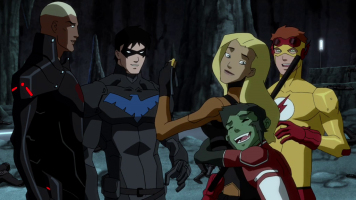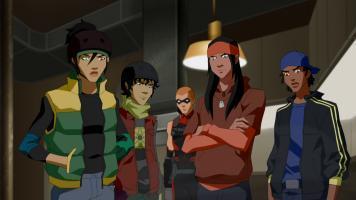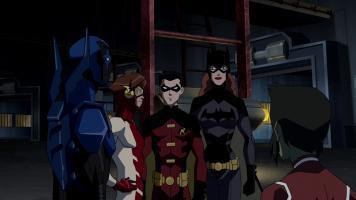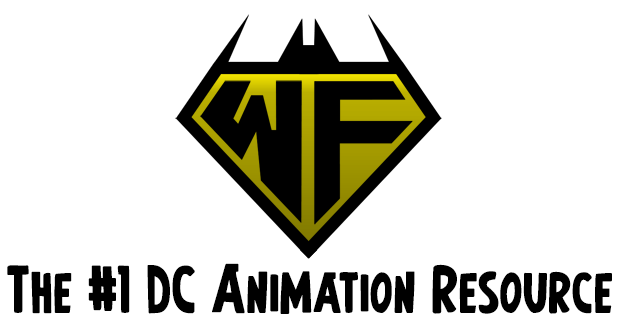
BACKSTAGE – INTERVIEW WITH BRANDON VIETTI
The World’s Finest: How did the second season of Young Justice expand on the journey and story of the original team?
 Brandon Vietti: Our team during Season One often challenged the decisions of their mentors or struggled with low self-confidence – very common teenage issues. For Season Two we wanted to turn the tables on those issues to see how it would affect our more matured leads. For example, we graduated Nightwing to the role of leader in Season Two where he found himself making the very kinds of decisions he challenged in Season One. Miss Martian found a greater sense of self after Season One but then struggled with personal and social boundaries while exploring her new found confidence in Season Two. These are real life issues we can all relate to and they take our whole lives to work out. And quite often when you feel that you’ve resolved one personal issue you find there’s some other new issue to resolve. We wanted Young Justice to be about these issues of growing up and growing older and the time jump between seasons helped us showcase the character growth needed to explore that concept with our Season One Team.
Brandon Vietti: Our team during Season One often challenged the decisions of their mentors or struggled with low self-confidence – very common teenage issues. For Season Two we wanted to turn the tables on those issues to see how it would affect our more matured leads. For example, we graduated Nightwing to the role of leader in Season Two where he found himself making the very kinds of decisions he challenged in Season One. Miss Martian found a greater sense of self after Season One but then struggled with personal and social boundaries while exploring her new found confidence in Season Two. These are real life issues we can all relate to and they take our whole lives to work out. And quite often when you feel that you’ve resolved one personal issue you find there’s some other new issue to resolve. We wanted Young Justice to be about these issues of growing up and growing older and the time jump between seasons helped us showcase the character growth needed to explore that concept with our Season One Team.
WF: Do you feel that season 2 addressed all of the ‘big’ questions concerning the 5 year gap? Why or why not?
BV: I think [Producer Greg Weisman] and I feel we addressed all the things the audience needed to know in order to understand and appreciate Season Two. But that doesn’t mean we addressed everything or even everything big. There are still a number of unanswered questions. A lot of stories left to tell – from the gap, from before Season One and from after Season Two. We think that’s the way it should be in order to make our universe feel real.
WF: What were your favorite character designs from the show? Why? What about your favorite settings or locations?
BV: Picking favorites is always hard! But I’m going to say that Sportsmaster is probably my favorite design. I think a lot of people saw him as a pretty cheesy character so he had a long way to go in Young Justice when we decided to make him into an elite enforcer. In terms of story, I think we had a good angle on him. But the design would make him or break him. Phil Bourassa and I kicked ideas back and forth about how to incorporate the sports theme in his costume but in a way that wasn’t silly and would play as practical, fear-inducing body armor. Sportsmaster needed to read as 100% pure badass at first glance. I think Phil nailed the design. I also loved Phil’s take on the Forever People.
As far as locations go, my favorite was the Watchtower. I knew I didn’t want a big, metal space station because I’ve seen that too many times in too may movies and TV shows. I wanted a location that was natural and mythic in beauty and beyond Earth technology. The only way I could think of to get a place like that was to have the Green Lanterns find a decommissioned base station that happened to be carved out of an asteroid and tow it to Earth. Background designer Hakjoon Kang and I traded sketches back and forth until we found the right design that pulled all these ideas together. I think the final result was pretty unique. The natural rock textures contrasting with smooth, carved surfaces and accents of glowing technology in the Watchtower echoed the aesthetic of Mount Justice but carried a more majestic sensibility. Plus, it had amazing views of Earth from the Mission Room!
WF: Young Justice already had an expansive cast when the second season began – but then a new super-hero team was brought in mid-way through. What was the idea behind creating a new team of teen heroes late into the season in an already populated show?
 BV: A lot of the decision was the natural outcome of the storyline. If the Light captures runaways for the Reach, and the Reach experiments on them, then some of those kids would have meta-genes and develop super-powers. We had to show the ramifications of that. But we were also trying, in the second half of Season Two, to continue the vibe of teenage life inside our superhero show. As I’ve said, the primary goal of Young Justice is to tell the story of teenagers coming of age. Being spies and/or superheroes follows in importance. Showing our leads just being teens is an important and unique texture for the series.
BV: A lot of the decision was the natural outcome of the storyline. If the Light captures runaways for the Reach, and the Reach experiments on them, then some of those kids would have meta-genes and develop super-powers. We had to show the ramifications of that. But we were also trying, in the second half of Season Two, to continue the vibe of teenage life inside our superhero show. As I’ve said, the primary goal of Young Justice is to tell the story of teenagers coming of age. Being spies and/or superheroes follows in importance. Showing our leads just being teens is an important and unique texture for the series.
Season One gave us more time to follow our leads as they lived their lives outside their costumes. I think the teenage vibe came through well because of that. But it was more challenging to incorporate that element into Season Two because of our hard driving storyline that necessitated more costume time among our young heroes. Our runaway characters helped balance the teenage vibe of the series. They were a great contrast to the Team in terms of visuals, experience, goals and personalities and they helped us play out vital story elements in a way our other leads could not.
WF: Lots of fans asked this one: Could you break down what is Asami’s power?
BV: Asami’s power gives her the ability to gather and channel the flow of her inner energy (chi, ki, or chakra). She can expel this energy to propel herself forward, cushion a landing or push things away from her. She can also reverse that flow which allows her to stick to a vertical surface for a short period of time. Reversing the energy flow only has an affect on things she touches and not objects outside her grasp. The pattern of concentric circles that trail behind her when leaping or project in front of her when pushing are supposed to represent an air disturbance. Asami’s body glows slightly as she utilizes her energy which also provides her a little protection from rough landings and impacts but won’t stop a bullet.
WF: You got to flex your writing muscle during the second season of Young Justice. Can you take us into the process of how you approached the episodes you wrote in season two? Did you find any difficulties in making sure you stuck to the overall themes the show was tackling, but also making sure you had a bit of leeway to do your own thing?
BV: I approached my first venture into script writing very carefully! I don’t need to tell you that Greg Weisman is a master at what he does. We had been planning all of the stories and themes of the show side by side from day one of development but when I wanted to make the move to writing a full script I knew I would be working under Greg. So I was pretty nervous about it. The last thing I wanted was to be the rookie writer causing problems. I guess my hard work paid off because Greg encouraged me to write a second script.
It wasn’t difficult for me to track themes or any other elements of the series while writing because Greg and I came up with all of that stuff together, alongside Kevin Hopps. Quite often, stories bubble up out all three of our heads as we spit out ideas, riff off of each other, and flesh something out we both like. Other times we bounce back and forth in taking the lead on story planning depending on who gets a stronger sense of what needs to be done for any given episode. In some cases, during Season One, I even wrote out beat sheets to pitch story ideas to Greg and our writers’ room. Graduating to full script writing felt like a natural progression for me. Having pros like Greg and the rest of our writing staff as guides for my first steps into the process was really inspiring and insightful. It was an incredible learning experience and I hope I get the chance to write a full script again.
WF: How far out in advance did you plan the series?
BV: We had the basics for the first three seasons or so almost from day one. We wanted a strong sense of where some story threads were going and where others were ending so that we could better plan the beginning and the middle. This allowed us to lay in all kinds of elements that would build to a conclusion even if you didn’t realize it while watching an episode the first time around. After you watch a full season of Young Justice you can rewatch all the episodes and often find deeper meaning or new meaning in some scenes and dialog.
WF: Any final thoughts on Young Justice? Perhaps one last behind-the-scenes tidbit or secret to reveal?
 BV: Here’s a little factoid that kinda ties in with your last question. Episode 215 (“War”) was one of the first stories ever planned for Young Justice. In the early stages of series development we were faced with a tough question: how can we make the adventures of a team of teenage sidekicks even more interesting and important than the adventures of the Justice League? I mean, if something really big was to happen in our show, wouldn’t it be more believable for the Justice League to handle it?
BV: Here’s a little factoid that kinda ties in with your last question. Episode 215 (“War”) was one of the first stories ever planned for Young Justice. In the early stages of series development we were faced with a tough question: how can we make the adventures of a team of teenage sidekicks even more interesting and important than the adventures of the Justice League? I mean, if something really big was to happen in our show, wouldn’t it be more believable for the Justice League to handle it?
To answer that question we created the War World scenario. Should the War World ever show up on Earth’s door step and threaten us with annihilation, the Justice League would be the ones, as expected, to shield the planet from the massive frontal assault. But, unexpectedly, a newly formed, secret group of teenage covert operatives would sneak into the War World from behind and shut the War World down from the inside! This was the dynamic of Young Justice and it helped us sell the show. But even then we knew it would take a lot of time to build to that scenario. And so the idea was condensed into two simple words, “War World”, scrawled onto a 3 x 5 card and pinned to the story wall for 2 years where it waited for us all to catch up to it in Season Two.
WF: Where can we expect to see your work in the future?
BV: My first ever comic book story is due out in stores on March 27th. I was honored to be invited by my teacher and mentor, Joe Kubert, to contribute a short story to the pages of Joe Kubert Presents #6. My original career goal 16 years ago was to become a comic book artist, so to finally have it happen and to get to work with Joe at the same time… well, “dream come true” doesn’t even really begin to sum up how amazing the experience was for me. Back at WB, I’m currently producing and directing a Scooby Doo movie where he and the Gang team up with WWE Superstars to solve a mystery. I’ve been wanting to work on a Scooby show since I started at WB so I was very excited to finally get the opportunity. Trust me – the movie is a ton of fun! It should be arriving in stores in early 2014.
“Young Justice” airs Saturdays at 10:30am (ET/PT) as part of DC Nation on Cartoon Network! The series finale episode “Endgame” airs at 10:30am (ET/PT) on March 16th, 2013.
Contact us and share your thoughts on social media via Twitter and Facebook pages!
